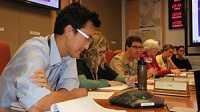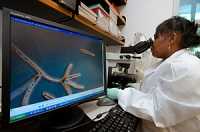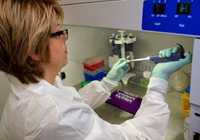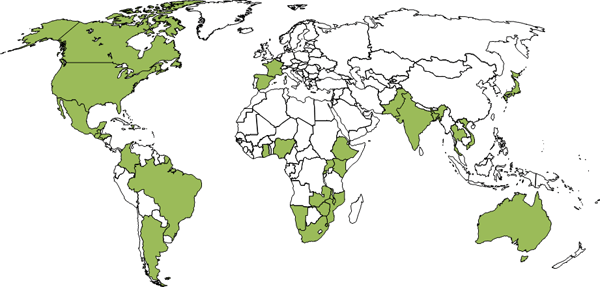Mycotic Diseases Branch
CDC’s lead group for the prevention and control of fungal infections in the United States and internationally through epidemiological and microbiological studies to improve the diagnosis, treatment, prevention, and control of mycotic diseases.
About Us
CDC’s Mycotic Disease Branch (MDB) is dedicated to preventing death and disability due to fungal diseases. As one of the only public health groups in the world devoted specifically to the prevention and control of fungal infections, MDB works with domestic and international partners to determine the burden of fungal infections, respond to outbreaks, and to address public health problems related to fungal infections.
- Increasing number of people with weakened immune systems. Opportunistic infections such as cryptococcosis and aspergillosis are becoming more problematic as the number with weakened immune systems rises – this includes cancer patients, organ transplant recipients, and people with HIV/AIDS.
- Advancements and changes in healthcare practices. Hospital-associated infections such as candidemia, a fungal bloodstream infection, are a major concern in the US. Advancements and changes in healthcare practices can provide opportunities for new and drug-resistant fungi to emerge in healthcare settings.
- Changes in the environment. Many fungal diseases, such as coccidioidomycosis (Valley fever) and histoplasmosis, are caused by fungi that live in soil or other parts of the natural environment. Weather and climate changes may be affecting these types of fungi.
Mycotic Diseases Branch Teams
Our Branch is composed of three teams. Epidemiology and laboratory staff members work together to generate new information about the burden of fungal diseases and disease-causing fungi, detect and identify fungi in clinical samples, investigate the source of fungal outbreaks, conduct applied public health research, and provide training in the identification of medically important fungi.
 The Fungal Epidemiology Team works to prevent disease and disability due to fungi by determining the burden of fungal infections, using available evidence to promote education and awareness of fungal diseases, address gaps in knowledge about prevention of fungal diseases, and work with domestic and international partners to provide response and support for fungal public health issues.
The Fungal Epidemiology Team works to prevent disease and disability due to fungi by determining the burden of fungal infections, using available evidence to promote education and awareness of fungal diseases, address gaps in knowledge about prevention of fungal diseases, and work with domestic and international partners to provide response and support for fungal public health issues.
We respond to outbreaks; monitor long term fungal disease trends; develop, evaluate, and promote cost-effective prevention guidelines and intervention strategies; and help prepare healthcare facilities and laboratories in resource-limited countries to better detect fungal diseases.
 The Fungal Service Team contributes to the prevention and control of fungal infections by facilitating detection, identification, and characterization of human fungal pathogens.
The Fungal Service Team contributes to the prevention and control of fungal infections by facilitating detection, identification, and characterization of human fungal pathogens.
The Fungal Reference Laboratory uses conventional and molecular methods to identify fungal isolates. We accept specimens from US state and international public health laboratories. Click here for specimen submission information . We conduct a yearly Mold Identification Training Course in collaboration with the Association of Public Health Laboratories. Click here for information about our course .
The Antifungal Testing Laboratory performs antifungal susceptibility testing on special populations of fungal isolates. We conduct surveillance studies to look for the presence and the proportions of fungal organisms that are resistant to antifungal drugs. We participate in the Clinical and Laboratory Standards Institute Subcommittee on Antifungal Susceptibility Testing and help evaluate various aspects of antifungal drug testing methods.
The Fungal Serology Laboratory uses antibody-based testing to detect exposure to fungal pathogens. We also conduct research into novel serologic testing methods.
 The Fungal Research Team contributes to the prevention and control of fungal infections by performing research on the molecular epidemiology of fungal infections, novel detection and diagnostic methods, and fungal molecular subtyping. This work allows us to incorporate and translate the newest research findings in the biology of human fungal pathogens to public health mycology. Some of our current work involves:
The Fungal Research Team contributes to the prevention and control of fungal infections by performing research on the molecular epidemiology of fungal infections, novel detection and diagnostic methods, and fungal molecular subtyping. This work allows us to incorporate and translate the newest research findings in the biology of human fungal pathogens to public health mycology. Some of our current work involves:
- Detection of fungi in the environment
- Detection of fungi in human specimens
- Producing a curated DNA sequence database for fungal identification
- Performing molecular epidemiology studies
- Collaborating in whole-genome sequencing projects for several fungal pathogens
Fungal Disease Outbreaks
When fungal disease outbreaks occur, our branch works with federal, state, local and territorial, and international public health officials and other partners to determine the cause, reduce illness and deaths, and to learn how to prevent future outbreaks. With systems in place for early identification for these types of events, our branch and its partners can continue to track, test for, respond to, and better understand emerging fungal health threats. Click here to learn more about recent fungal disease outbreaks.
Click here to learn more about recent fungal disease outbreaks .
International Activities
Our branch has assisted in the onsite development, execution, analysis, and publication of numerous studies all over the globe. We work with many international partners in a wide variety of areas, particularly with the assessment and prevention of opportunistic fungal infections among persons with HIV/AIDS. For example, we are working with public health and healthcare agencies in several countries to implement programs that aim to reduce the burden of cryptococcal disease.
For more information about our international work, please visit our Global Fungal Diseases web page.
Below is a map of some of the places we’ve worked during the last 5 years:

- Page last reviewed: May 2, 2016
- Page last updated: January 27, 2017
- Content source:


 ShareCompartir
ShareCompartir